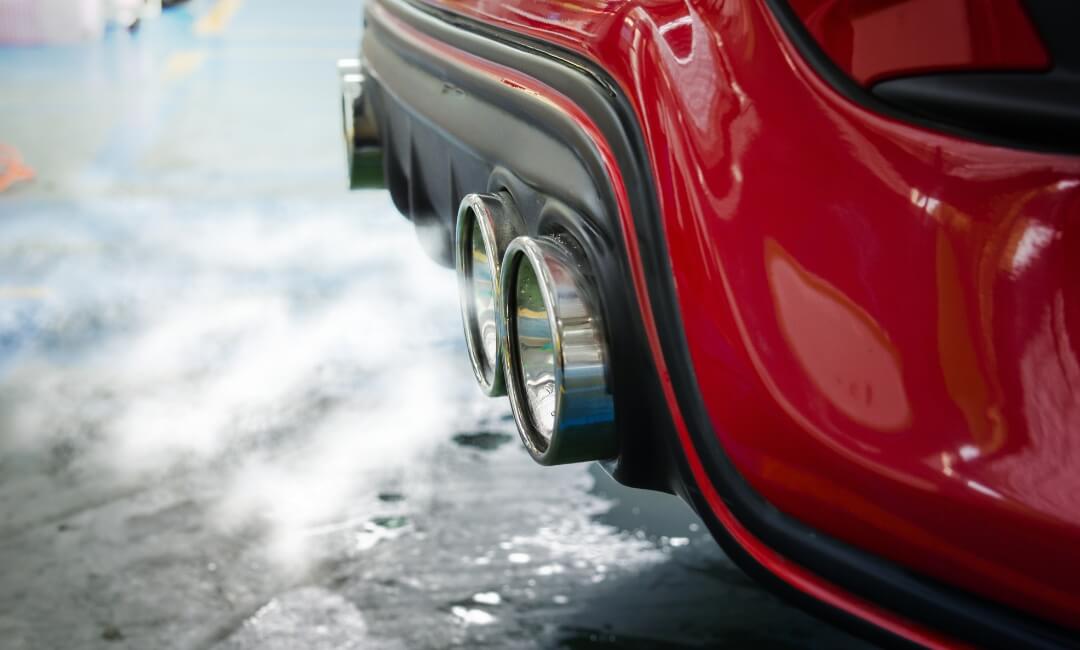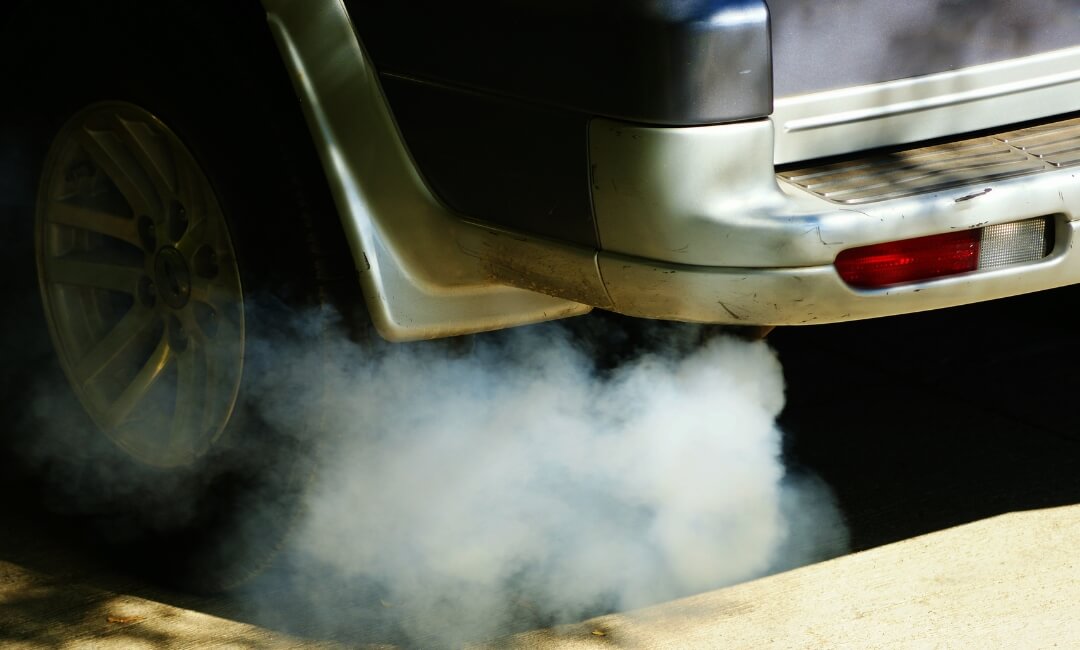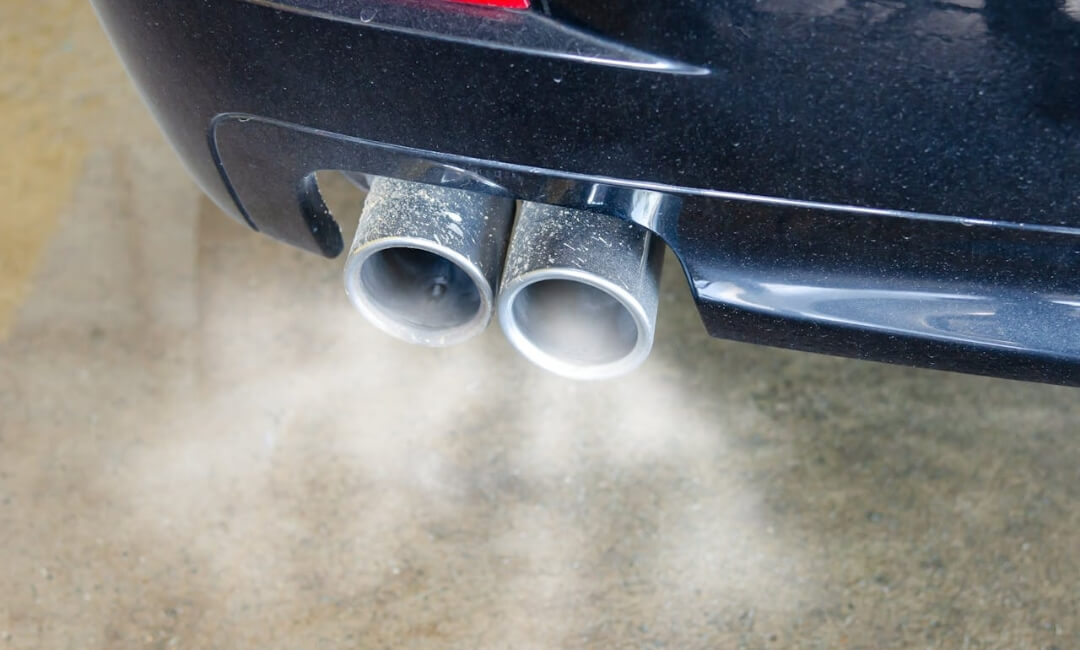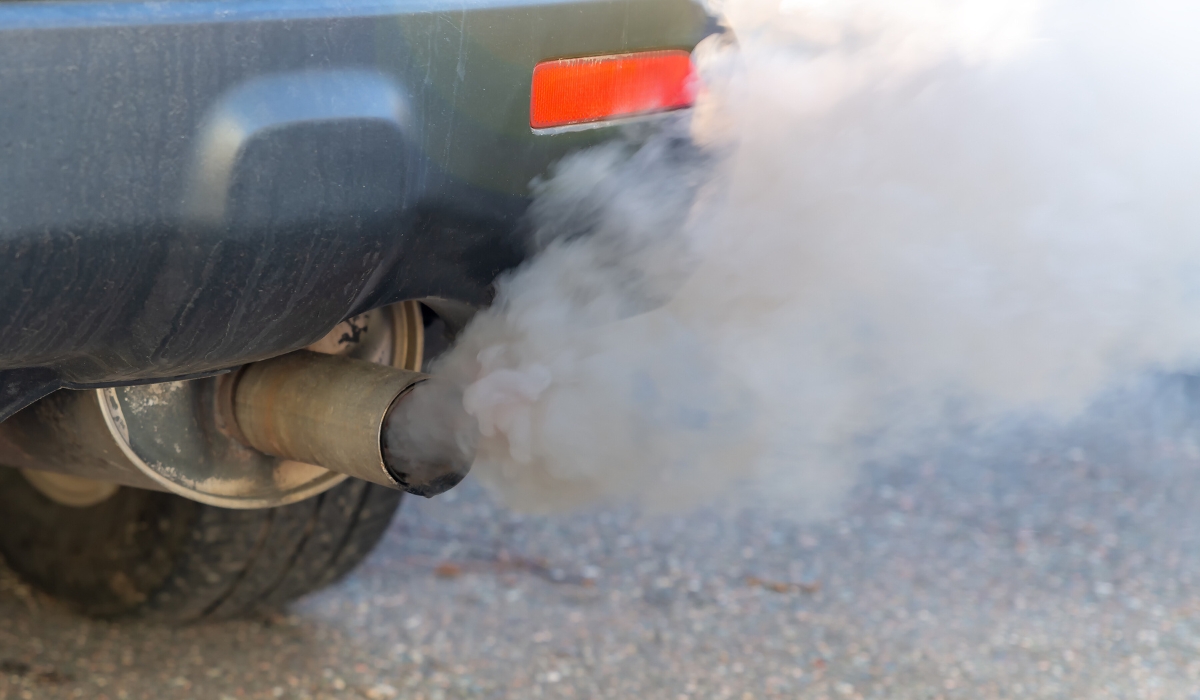People should be careful if they start their car and see white exhaust smoke. There’s no reason this is scary if you don’t know why. White smoke, upon starting, especially on chilly mornings, is frequent and usually fades as the engine warms up. However, knowing the reasons for this transient white smoke might help you decide whether it’s innocuous or indicates a more significant condition. In this post, we’ll cover white smoke during startup, when it’s okay, and when it may signal underlying issues. This guide will help you make educated automobile health choices, whether you are a veteran or a newbie.
White exhaust smoke is usually most evident in the initial few seconds after starting your automobile, especially if it has been idle or cold. This white smoke generally steams from nighttime exhaust condensation. The heat from starting your engine evaporates this condensation, producing a small puff of white smoke. This smoke is usually safe and should vanish within minutes as the engine heats up.
If the white smoke persists after the engine warms up or is abundant, it may indicate a more significant problem. A coolant leak may create continuous white smoke. White smoke comes from the exhaust when coolant seeps into the engine and burns. This generally indicates a blown head gasket, broken engine block, or damaged cylinder head, which needs quick care. If exhaust smoke smells sweet, coolant is likely to blame. Ignoring this problem might cause severe engine damage, so fix it immediately.
A leaky fuel injector may cause startup white smoke. Leaky fuel injectors allow extra gasoline to enter the engine cylinders while the car is off, resulting in a rich fuel mixture during restart. White smoke may remain until the surplus fuel is burnt. A fuel injector leak may affect engine performance, fuel economy, and emissions, although it is less risky than a coolant leak.
Incomplete combustion may create a diesel engine starter white smoke. Common causes include cold engine temperatures, low fuel quality, and fuel injection difficulties. Diesel engines may emit white smoke until they reach operating temperature in colder areas, which is usually harmless. However, persistent white smoke may indicate blocked fuel injectors, insufficient compression, or a faulty glow plug. Regular maintenance and high-quality gasoline may avoid these concerns.
Starting exhaust white smoke is usually innocuous, but its features and duration should be monitored. A little puff of white smoke that vanishes is typically steam and harmless. If the smoke persists or is accompanied by other symptoms, it may suggest a coolant leak, fuel injector leak, or combustion problems, particularly in diesel engines. Understanding these issues might help you maintain your car and prevent expensive repairs.
1. Understanding White Smoke from the Exhaust

What Is White Smoke?
It gives off white smoke when your car starts up. You can see this thin, hazy air most clearly in the winter. In contrast to black or blue smoke, white smoke comes from water vapor in the exhaust system. This gas could be caused by several things, ranging from humidity to problems inside the engine.
Differences Between White, Black, and Blue Smoke
Knowing the types of smoke could help figure out what’s wrong:
- White Smoke : Usually means vaporized water. As with dampness, it could be nothing or mean water leaks into the engine.
- Black Smoke: It generally means the car has too much fuel. Something like a blocked air filter, fuel injector, or fuel pressure valve could be to blame for this.
- Blue Smoke: Usually means that the engine oil is burning. If the piston rings, valve seals, or other parts of the engine are worn out, oil could get into the combustion chamber.
Why White Smoke Is More Common During Cold Weather?
It is more common for white smoke to form in cold weather because of condensation in the exhaust system. When the engine is cold, damp air may collect in the exhaust pipes and mufflers. When the exhaust system warms up, this water turns into steam. This makes a puff of white smoke when you start your car. This thin smoke goes away quickly when the engine is at room temperature.
The engine and exhaust system take longer to warm up when it’s cold outside. This means that white smoke may be more leisurely to see in the beginning. It’s normal for the smoke to go away when the engine and tailpipe get warmer.
Common Misconceptions About White Smoke
An urban legend says that all white smoke means a significant issue. White smoke that doesn’t go away could mean a radiator leak. When the engine is first started, a small puff of white smoke is usually nothing to worry about. Another myth is that white smoke always means the head seal is broken. Broken engine blocks or cylinder heads that are leaking could also cause white smoke.
When to Start Worrying
It would help if you told me the difference between regular white smoke from humidity and smoke, which is a problem. The white smoke could be humidity that burns off after a while. But if the smoke stays after the engine starts up or comes with other signs like a pleasant smell (which means coolant is burning), boiling, or a drop in the coolant level, you should look into it more. These signs could point to a more severe problem that needs quick attention from a mechanic.
2. What Causes White Smoke from the Exhaust on Startups?

Start-up white smoke from the exhaust could mean there are problems with the engine. If you know the reasons, you can tell if the trouble is minor or more significant. These common reasons for white smoke at the start:
Condensation Build-up:
Overnight, especially in cold or wet places, moisture may build up in the exhaust system. It’s not dangerous, but this water mist might make white smoke when you start your car in the morning. The smoke goes away after a few minutes as the engine heats up and the moisture leaves the air. This is normal, but white smoke that won’t disappear could mean a bigger problem.
Coolant Leak:
Coolant leaks commonly cause white smoke when you start your engine. It smells good when thick white smoke comes out of the combustion chamber when coolant burns with the fuel and air. The cylinder head, engine block, or head seal could be broken. If you don’t get a professional to look at and fix any of these problems immediately, they could eventually cause significant engine damage.
Worn Piston Rings or Valve Seals:
Oil or water can enter the combustion area when the piston rings and valve plugs wear out. Oil or water burns with gasoline while the engine runs, creating white smoke.
This steady smoke could mean oil is burning, hurting the engine’s performance and wear. If white smoke keeps coming out of your engine after it starts up, you should have a professional look at it.
Faulty Fuel Injector:
It doesn’t happen often, but white smoke could come from a broken fuel injector when the car starts up. Lack of integrity in injectors lets extra fuel into the combustion area.
This leads to white smoke and incomplete burning. This problem often leads to rough running, slow movement, and using a lot of gas.
Cold Weather Effects:
When it’s freezing outside, starting your car can sometimes make white smoke because of the low temperature. When you start your engine, the cold air compresses the fuel, making a mist you can see. As the engine starts up, this smoke should go away. But if the smoke keeps coming out, it could mean one of the problems listed above, like a coolant leak or old piston rings.
Also Check: How Long Does It Take to Replace or Fix Spark Plugs?
Incorrect Fuel Mixture:
Insufficient air or too much fuel could keep the fire going. A cloud of white smoke will appear. Usually, this problem is caused by sensors or fuel injectors. Taking care of your car’s fuel system will keep this from happening.
If your car’s exhaust gives off white smoke, it could be safe, like from being wet, or it could mean a water leak, old engine parts, or a question with the fuel system. You should take your car to a repair to fix it if it creates white smoke. This will keep the engine safe and help it stand up.
3. When Should You Be Concerned About White Smoke
White smoke from car fumes is scary. Smoke is every day when cold starts, but heavy, long-lasting smoke needs help. Most of the time, water gets into the engine when the head gasket or block breaks. When this coolant burns with gasoline, white smoke is made. This could make your engine overheat and break.
In some types, white smoke may come from transmission oil that is on fire. A pleasant smell could mean that the antifreeze is burning, which means there are problems with the cooling system. It would help if you didn’t ignore these signs because they could lead to fixes that cost a lot of money.
If you do regular upkeep, you can avoid these problems. Regularly check for leaks and low coolant levels. Getting a trained expert to look at any problems immediately is very important. If you don’t fix the white smoke, it could break your engine, leaving you stuck and costing a lot. You might save money and keep your car running well if you act quickly.
4. Diagnosing the Problem
Finding the cause of a car problem is like putting together a puzzle, and it’s essential for the health of your car. Sounds that come on quickly, power cuts, and panel lights may all be signs of a problem. If you find the reasons, you might keep yourself safe and save money.
To help with the diagnosis, listen for noises, movements, and leaks. Brakes that squeal could mean that parts are broken, and an engine that stutters could mean that the spark plugs are broken. An OBD-II reader can pull out error numbers that help narrow the list of possible problems.
Look at how often you’ve had your car serviced. This could mean that the problems keep happening. Check the manual with your car for advice specific to your model. Fixing minor problems, like changing the gas cap, may help with bigger ones.
If you have serious worries, you should see a doctor. To evaluate well, you must carefully watch the vehicle, use the right tools, and know its past. Troubleshooting and being cautious can help your car last longer, keep it safe, and keep minor problems from turning into big ones that cost a lot to fix. Keep an eye on things to ensure your car runs quickly and safely!
5. Solutions to Address White Smoke Emission from the Exhaust

The cause of the white tailpipe smoke tells us what to do:
- Condensation: When it’s cold in the morning or after cars run, condensation makes white smoke. Heat turns the water in the air into steam. Don’t worry—this is normal and will go away as the engine starts.
- Coolant Leak: There is more damage when white smoke comes from a water leak in the engine block, cylinder head, or head gasket. When coolant leaks into the engine tanks and burns with petrol, white smoke is made. Finding the break is essential for solving this. Some repairs that might be needed are changing the head gasket, fixing a broken engine block, or fixing other broken parts. Ignoring the problem could lead to the engine burning or breaking down, so something must be done immediately.
- Worn Engine Components: The engine has a lot of wear. Cylinders, piston rings, and valve seals wear out fast. As oil runs into the combustion chamber, it goes over worn rings and plugs and starts to burn. This makes white smoke. To fix this, replace the broken parts. This complex and pricey fix gets the engine working again and keeps problems from happening again. If you don’t replace old parts, more damage will happen. Engines last longer and work better when they get regular repairs.
6. Proactive Steps to Prevent Future White Smoke Emissions
It would help if you did regular repairs to keep white smoke from coming from your tailpipe. To keep your engine in good shape, do the following:
1. Regular Coolant Level Checks:
As a matter of course, you should check the radiator levels often. Low amounts of coolant could be an early sign of a leak, which could later cause white smoke to come out of the engine. It might help you find problems before they worsen if you continuously ensure the water level stays at the right level.
2. Timely Oil Changes:
Regular oil changes can extend the life of an engine. Due to old or dirty oil, white smoke can be caused by engine parts breaking down. Replace your oil as often as the maker tells you to to keep your engine from wearing out and giving off white smoke.
3. Monitor Engine Performance:
Keep an eye on how your car runs. Quickly act if you smell or hear strange sounds or your engine warning light comes on. It would help if you took care of them quickly to stop white smoke and other engine problems before they worsen.
4. Regular Engine Inspections:
Along with regular checkups, you should have the engine inspected often. A mechanic is trained to carefully check your car for problems and find them before they get worse. This method may keep you from paying too much money for fixes and worrying about white smoke.
5. Quality Repairs and Parts:
When you need to replace or fix a part, use high-quality parts and professional help. Problems that keep happening, like white smoke, could be caused by bad parts or repairs that aren’t done right. Good fixes will make your car last longer and run better.
6. Driving Habits:
The way you drive could hurt your engine. If you idle your car too long, ice could form in the exhaust system and cause white smoke. Do not drive in extreme situations, as they may make the engine wear out faster and produce white smoke.
7. Responding to Early Signs:
Do not ignore the first signs of white smoke, like a faint smell of oil or coolant on fire. Check it out, even if the smoke seems small or short-lived. If problems are found and fixed quickly, they might not get worse and cost more to fix later.
If you take these steps, tailpipe white smoke may go down a lot. Regular care and maintenance will keep your car in great shape and make it last longer. Remember that an engine that is well taken care of makes less white smoke, which makes driving safer.
Conclusion
White smoke from starter exhaust might worry, but knowing its source will help you fix it. This is usually caused by exhaust system condensation, which is expected in colder weather and harmless if the smoke evaporates. If the white smoke remains or happens at warmer temperatures, it may suggest a coolant leak or head gasket trouble.
In such instances, visit a skilled technician immediately to avoid engine damage. Maintaining your car and monitoring its behavior helps save expensive repairs. Watch your vehicle’s performance and get professional help if you observe white smoke on starting. Being aware of these indications prolongs the life of your car and keeps you safe. Early detection may save costly repairs. Thus, automobile owners should do it.




